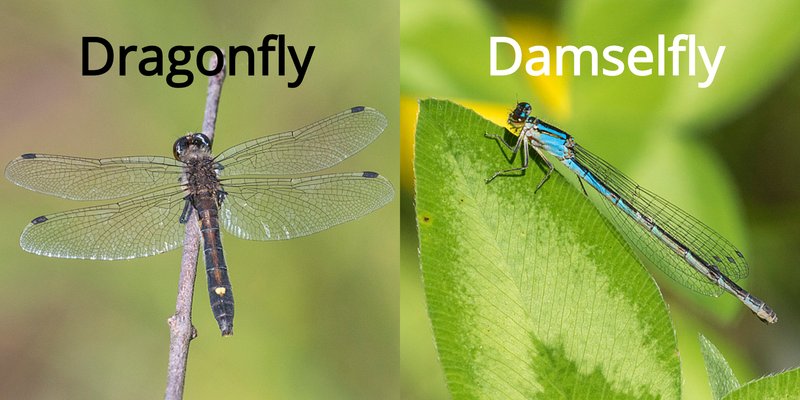
To keep it simple, think of dragonflies as the race cars of the insect world. They are fast, agile, and can change direction in a split second—almost like they have a mind of their own. On the other hand, insects like damselflies are more like bicycles; they’re graceful but lack the raw speed and maneuverability of dragonflies. So, grab a cup of coffee as we dive into this comparison of dragonflies and their insect cousins!
What Are Dragonflies?
Dragonflies belong to the order Odonata and are known for their long bodies and two pairs of large wings. They have incredible flying skills, able to hover in midair, fly backward, and even turn on a dime. Their diet mainly consists of mosquitoes, flies, and other small insects, making them fantastic natural pest controllers.
One of the most striking features of dragonflies is their vibrant colors. Depending on the species, you might see hues of blue, green, red, or yellow. They often boast iridescent wings, which not only play a role in attracting mates but also in camouflage against predators. Did you know that dragonflies can live for several years in their nymph stage, usually under water, before they metamorphose into adults? It’s a fascinating life cycle that adds depth to their character.
Dragonflies vs. Damselflies: What’s the Difference?
At first glance, dragonflies and damselflies might look pretty similar, but they have some key differences. Damselflies are generally smaller and more delicate. Their wings are usually held together above their bodies when at rest, while dragonflies hold theirs open.
Another noticeable difference is in the size and shape of their bodies. Dragonflies have bulkier, more robust bodies compared to the slender, fragile look of damselflies. You might even find them in similar environments, like ponds or marshes, but while dragonflies are often seen zipping around, damselflies tend to fly more slowly and gracefully from plant to plant.
It’s like comparing a thick, hearty novel to a light, breezy magazine—both have their charm, but they cater to different vibes!
The Life Cycle of Dragonflies
Understanding dragonflies wouldn’t be complete without diving into their life cycle. It begins with the female laying her eggs in or near water. When the eggs hatch, they become nymphs, living underwater for up to several years. This stage is often unnoticed by many, as they’re usually hidden among plants or debris.
As nymphs, they’re predatory too, feeding on other aquatic creatures. When the time is right, they climb out of the water and molt into their adult form, leaving their nymph exoskeleton behind. This transformation is like a real-life magic trick! The newly emerged dragonfly has to pump fluid into its wings to expand them before it takes flight for the first time.
This life cycle not only influences their habitat but also plays a huge role in their ecological importance, especially in controlling insect populations both underwater and on land.
Comparing Dragonflies to Mayflies
Now let’s shift gears and look at mayflies. While both dragonflies and mayflies are aquatic, their life cycles and behaviors differ significantly. Mayflies have a much shorter adult life, often lasting just a few hours to a couple of days. This fleeting existence is often spent mating; it’s as if they know they have to make the most of their brief time above water.
In the nymph stage, mayflies can live for months or even years underwater, but once they emerge as adults, they focus on reproduction. They don’t even have functional mouths for eating during this stage! In contrast, dragonflies, with their robust bodies and powerful jaws, can hunt and eat throughout their entire adult life.
So, if dragonflies are like race cars, then mayflies are the brief but stunning fireworks at a summer festival—beautiful but gone in a flash.
Ecological Importance of Dragonflies
Dragonflies play a vital role in their ecosystems. As both hunters and prey, they help maintain balance in the food web. Their presence indicates healthy aquatic habitats since they thrive in clean water.
By keeping populations of smaller insects in check, dragonflies naturally help control pests that can affect crops and gardens. On the flip side, they also serve as food for birds, fish, and other larger insects. It’s a classic example of nature’s interconnectedness.
When you see a dragonfly flitting around your yard or local park, remember they are not just beautiful creatures but important players in the ecological game.
Challenges Facing Dragonflies
Despite their resilience, dragonflies face several challenges today. Habitat destruction, pollution, and climate change are significant threats to their populations. Wetlands and ponds, their natural habitats, are disappearing at an alarming rate.
Pollution can deteriorate the water quality they rely on during their nymph stage. With changing weather patterns, their breeding and migration patterns are also affected. This is concerning, not just for dragonflies, but for the broader ecosystem since their decline could lead to a surge in pests that they naturally keep in check.
Conservation efforts are crucial to protect these wondrous insects. If you want to help, consider supporting local organizations that work to preserve wetlands or create a dragonfly-friendly environment in your garden. Simple things like adding a water feature can make a big difference!
In comparing dragonflies to their similar insects, it’s clear each group has its unique charm and purpose. From the speed and agility of dragonflies to the delicate beauty of damselflies and the fleeting life of mayflies, these creatures are integral to our ecosystems.
The next time you spot a dragonfly zooming past, take a moment to appreciate not just its beauty but its role in nature. Understanding these insects more deeply allows us to see how interconnected we all are and emphasizes the importance of preserving our natural habitats. Let’s work together to ensure these magnificent insects continue to grace our skies for generations to come!
